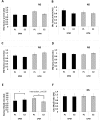Estradiol-mediated improvements in adipose tissue insulin sensitivity are related to the balance of adipose tissue estrogen receptor α and β in postmenopausal women
- PMID: 28472101
- PMCID: PMC5417515
- DOI: 10.1371/journal.pone.0176446
Estradiol-mediated improvements in adipose tissue insulin sensitivity are related to the balance of adipose tissue estrogen receptor α and β in postmenopausal women
Abstract
We recently demonstrated that short-term estradiol (E2) treatment improved insulin-mediated suppression of lipolysis in postmenopausal women, but to a greater extent in those who were late compared to early postmenopausal. In this follow-up study we tested whether subcutaneous adipose tissue (SAT) expression of estrogen receptors (ER) α and β differs between early and late postmenopausal women. We further tested whether the balance of ERα to ERβ in SAT determined the effect of E2 on SAT insulin sensitivity. The present study included 35 women who were ≤6 years past menopause (EPM; n = 16) or ≥10 years past menopause (LPM; n = 19). Fasted SAT samples were taken following 1-week transdermal E2 treatment or placebo (PL) in a random cross-over design. Samples were analyzed for nuclear/cytosolic protein content and mRNA expression using Western blot and qPCR, respectively. While ESR1 increased slightly (~1.4-fold) following E2 treatment in both groups, ERα and ERβ protein expression did not differ between groups at baseline or in response to E2. However, the balance of ERα/ERβ protein in the SAT nuclear fraction increased 10% in EPM compared to a 25% decrease in LPM women (group x treatment interaction, p<0.05). A greater proportion of ERα/ERβ protein in the nuclear fraction of SAT at baseline (placebo day) was associated with greater reduction in SAT insulin resistance (i.e., better suppression of lipolysis, EC50) in response to E2 (r = -0.431, p<0.05). In conclusion, there do not appear to be differences in the proportion of adipose tissue ERα/ERβ protein in late, compared to early, postmenopausal women. However, the balance of ERα/ERβ may be important for E2-mediated improvement in adipose tissue insulin sensitivity.
Trial registration: Clinical Trials#: NCT01605071.
Conflict of interest statement
Figures





References
-
- Carr M.C., The emergence of the metabolic syndrome with menopause. J Clin Endocrinol Metab, 2003. 88(6): p. 2404–11. doi: 10.1210/jc.2003-030242 - DOI - PubMed
-
- Salpeter S.R., Walsh J.M., Ormiston T.M., Greyber E., Buckley N.S. and Salpeter E.E., Meta-analysis: effect of hormone-replacement therapy on components of the metabolic syndrome in postmenopausal women. Diabetes Obes Metab, 2006. 8(5): p. 538–54. doi: 10.1111/j.1463-1326.2005.00545.x - DOI - PubMed
-
- Van Pelt R.E., Gozansky W.S., Schwartz R.S. and Kohrt W.M., Intravenous estrogens increase insulin clearance and action in postmenopausal women. Am J Physiol Endocrinol Metab, 2003. 285(2): p. E311–7. doi: 10.1152/ajpendo.00490.2002 - DOI - PMC - PubMed
-
- Van Pelt R.E., Schwartz R.S. and Kohrt W.M., Insulin secretion and clearance after subacute estradiol administration in postmenopausal women. Journal of Clinical Endocrinology and Metabolism, 2008. 93(2): p. 484–90. doi: 10.1210/jc.2007-1657 - DOI - PMC - PubMed
-
- Pereira R.I., Casey B.A., Swibas T.A., Erickson C.B., Wolfe P. and Van Pelt R.E., Timing of Estradiol Treatment After Menopause May Determine Benefit or Harm to Insulin Action. J Clin Endocrinol Metab, 2015. 100(12): p. 4456–62. doi: 10.1210/jc.2015-3084 - DOI - PMC - PubMed
Publication types
MeSH terms
Substances
Associated data
Grants and funding
LinkOut - more resources
Full Text Sources
Other Literature Sources
Medical
Research Materials
Miscellaneous

